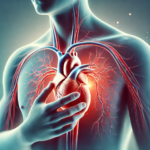💊 What is Atherosclerosis?
Atherosclerosis is the progressive buildup of fatty deposits, cholesterol, calcium, and other substances (collectively known as plaque) within the inner walls of arteries. Over time, this plaque accumulates and increases in size, hardens, and narrows the arteries – progressively restricting blood flow and reducing oxygen delivery to vital organs and tissues. The process begins with damage to the endothelium (the inner lining of the artery), which can be triggered by factors like high blood pressure, smoking, or high cholesterol.
The body’s immune response attempts to repair this damage and break down these substances, but immune cells inadvertently end up contributing to plaque formation with their biomass. Atherosclerosis can affect any artery in the body, but it most commonly targets arteries supplying the heart (coronary arteries), brain (carotid arteries), legs (peripheral arteries), and kidneys. As plaque grows, it can rupture and spill its content into the vessel, leading to the clot formation that can completely block the artery and result in serious conditions like heart attacks, strokes, or peripheral artery disease.
🤔 Why you need to know:
Atherosclerosis is insidious. It develops silently over many decades and we all have it. On top of that, it is also the leading cause of heart disease and stroke. Identifying risk factors early, such as high cholesterol, high blood pressure, and smoking, is crucial for prevention. Practical steps include:
- Dietary Changes: Incorporate more fruits, vegetables, whole grains, and healthy fats while reducing intake of trans fats and added sugars.
- Regular Exercise: Engage in aerobic activities like walking, swimming, or cycling to improve cardiovascular health.
- Monitor Blood Pressure and Cholesterol: Regular check-ups and lifestyle adjustments can help keep these levels in check.
🧠 Trivia:
Some animals, particularly domestic pets like dogs and cats, can develop atherosclerosis as well, though it is much rarer in them compared to humans. Interestingly, certain species of primates and birds kept in captivity have shown signs of atherosclerosis, especially when fed diets high in cholesterol and fat. This condition has even been observed in zoo animals, such as parrots and gorillas, highlighting that lifestyle factors play a significant role in heart health across species. We are a bad influence.



